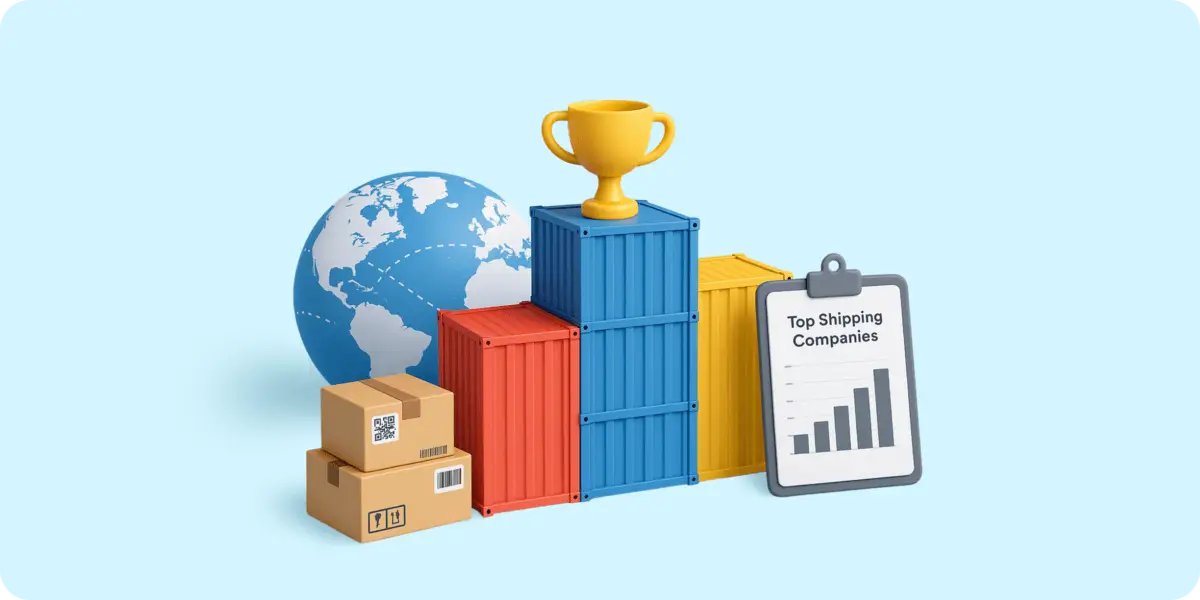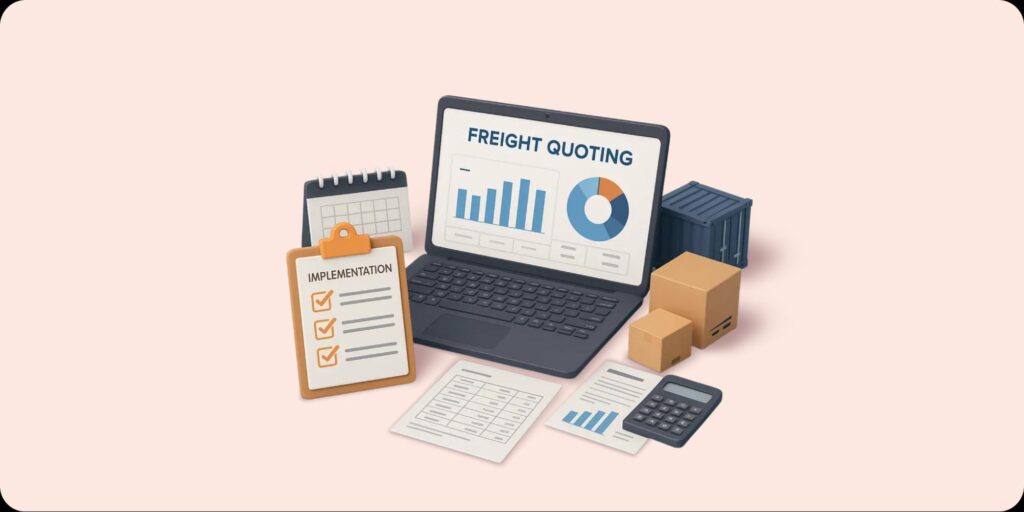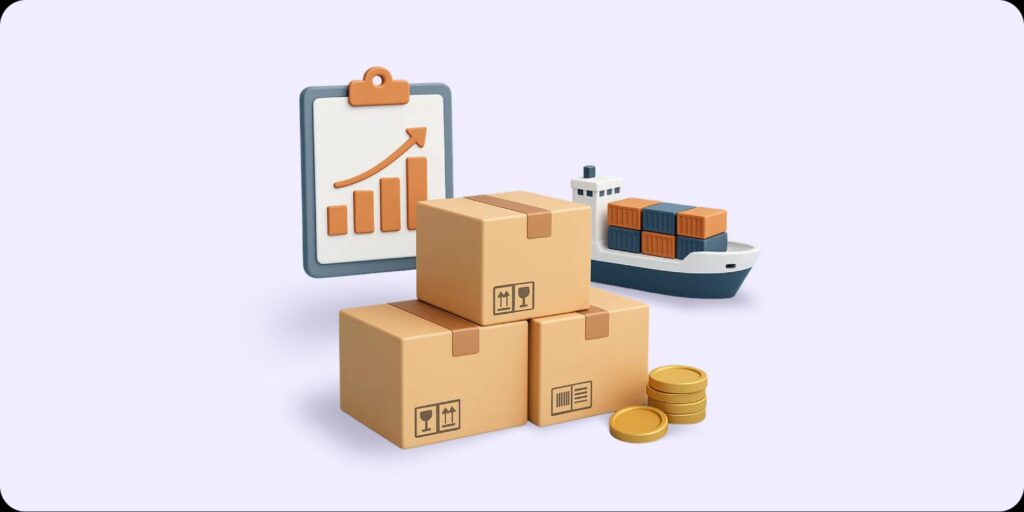Key Takeaways
- Ocean freight forwarders manage end-to-end shipping, from negotiating contracts to handling customs, making international shipping more accessible, cost-efficient, and compliant for businesses.
- The top 20 global forwarders include Kuehne + Nagel, DHL, DB Schenker, and DSV, offering services like FCL/LCL shipping, warehousing, insurance, and multimodal delivery with worldwide coverage.
- Choosing the right forwarder requires evaluating route expertise, digital capabilities (like APIs), customer service, and fit for your industry and cargo volume.
- Automating documentation, booking early, and leveraging consolidation can reduce shipping costs, minimize delays, and improve operational efficiency.
- Wisor reduces quote turnaround by 85% by aggregating live rates, automating documentation, and integrating seamlessly with your tech stack for full visibility and faster, smarter forwarder selection.
What Are Ocean Freight Forwarders?
Today, ocean freight remains the backbone of global trade. Roughly 80% of all goods worldwide are transported by sea. Between 1990 and 2023, the volume of cargo shipped grew from about 4 billion tons to over 12 billion tons – more than tripling in three decades.
This explosive growth underscores ocean freight’s position as the most cost-efficient method of moving goods internationally. Shipping by sea is estimated to be 12–15 times less expensive than air freight, while also producing lower carbon emissions per kilogram than any other mode of transport.
Ocean freight forwarders play a pivotal role in making this system work. They negotiate shipping contracts, manage scheduling and route planning, and coordinate directly with carriers. Beyond that, they handle complex requirements such as selecting Incoterms, arranging insurance, preparing compliance documentation, and securing licenses necessary for cross-border movement. Naturally, forwarders charge fees for providing these services.
In short, freight forwarders make ocean shipping, and its cost and environmental advantages, far more accessible to businesses worldwide.
Top 20 Ocean Freight Forwarders
With hundreds of ocean freight forwarders available in the market, the options can feel overwhelming. Choosing the right partner requires careful research, reviewing credentials, and comparing multiple providers.
This curated list of the top ocean freight forwarders serves as a starting point for shippers. From here, businesses should evaluate quotes, service offerings, and route expertise to select the best fit for their cargo and shipping needs:
| Rank | Ocean Forwarder | Headquarters | Estimated Ocean Freight Volume (TEUs) | Coverage |
|
1 |
Kuehne + Nagel | Switzerland | 4,310,000 |
Global (offices in ~100 countries) |
|
2 |
DHL Global Forwarding | Germany | 3,314,000 |
Global (worldwide operations) |
|
3 |
DB Schenker | Germany | 1,810,000 |
Global |
|
4 |
DSV | Denmark | 2,686,009 |
Global |
|
5 |
Sinotrans | China | 4,872,248 |
China and regional (expanding globally) |
|
6 |
C.H. Robinson | United States | 1,428,200 |
|
|
7 |
CEVA Logistics | France | 1,900,000 |
Global |
|
8 |
Nippon Express | Japan | 1,850,979 |
Global |
|
9 |
GEODIS | France | 787,000 |
|
|
10 |
Expeditors | United States | 846,800 |
|
|
11 |
Kerry Logistics (KLN) | Hong Kong | 1,238,108 |
Asia-focused with global reach (Greater China + Southeast Asia emphasis) |
|
12 |
Hellmann Worldwide Logistics | Germany | 955,000 |
Airfreight, seafreight, road & rail freight, contract logistics |
|
13 |
Yusen Logistics | Japan | 632,000 |
Global — ~748 centers in 46 countries |
|
14 |
Maersk Logistics | Denmark | 660,000 |
Global — network across ports, inland services in 48 countries |
|
15 |
UPS Supply Chain Solutions | United States | 567,000 |
|
|
16 |
Toll Group | Australia | NA |
|
|
17 |
Flexport | United States | NA |
|
|
18 |
Scan Global Logistics | Denmark | 550,000 |
|
|
19 |
Seko Logistics | United States | 285,900 |
|
|
20 |
Dachser | Germany | 540,936 |
|
Ocean Freight Services Breakdown
Ocean freight is usually negotiated port-to-port under Incoterms, but most freight forwarders also provide a range of additional services to support shippers throughout the supply chain.
- Container Shipping Options: Ocean freight is usually measured in TEU (Twenty-foot Equivalent Unit) and FEU (Forty-foot Equivalent Unit). Since FEU pricing is generally more cost-efficient per unit of volume, shippers often find better value when comparing rates in FEU rather than TEU.
- Full Container Load (FCL): When it comes to shipping methods, a Full Container Load (FCL) involves moving an entire container, either TEU or FEU, under the control of a single shipper.
- Less Than Container Load (LCL): In contrast, Less Than Container Load (LCL) services allow multiple shippers to share container space, with forwarders consolidating different cargoes into one container. This shared approach reduces costs by splitting both the space and the associated shipping expenses.
- Value-Added Logistics Services: Beyond basic freight movement, many forwarders provide a range of value-added services designed to simplify and optimize the shipping process. These can include container loading and handling, preparation of documentation and licensing, and management of duties and insurance. Some forwarders also offer customized solutions tailored to specific cargo needs, as well as sustainable shipping options that reduce environmental impact while ensuring efficiency.
- Customs Clearance: Depending on the agreed Incoterms, forwarders may handle customs clearance on behalf of shippers. Some even pre-pay duty fees and include them in the invoice.
- Warehousing & Storage: Forwarders often provide short-term warehousing and storage at the port, either before loading or while awaiting carrier alignment.
- Insurance Services: Insurance packages are frequently bundled with freight services to protect shipments in transit.
- Pickup and Last-Mile Delivery: Multi-modal forwarders can manage door-to-door shipping, including drayage and last-mile delivery. Others may transfer cargo to rail or truck carriers from the port of arrival.
How to Choose the Right Ocean Freight Forwarder
At first glance, most ocean freight forwarders appear similar. However, many provide unique services, specialize in certain industries, or focus on specific shipping volumes. Selecting the right partner requires more than just comparing quotes. It means finding the forwarder that best matches your industry, cargo type, shipping volume, and trade lanes.
Geographic and Industry Fit
Some freight forwarders concentrate on particular regions or trade lanes, while others maintain extensive global networks. Working with a local forwarder can simplify documentation and regulatory compliance, especially in regions where language and legal requirements present challenges. On the other hand, a global forwarder may offer greater efficiency if your shipments move across multiple jurisdictions.
Industry expertise is equally important. Each sector has its own logistics requirements at the port of loading, during transit, and upon arrival at the destination. Partnering with a forwarder that understands the demands of your industry helps ensure a smoother, more reliable shipping process.
Shipment Volume and Type Compatibility
Depending on the nature of your goods, factors such as licensing, cargo insurance, and specialized solutions like refrigerated transport or hazardous material handling may be essential. Smaller freight forwarders often provide more personalized service and tailored solutions, while larger providers typically offer greater scalability and broader options for load consolidation.
Availability of Digital Tools and APIs
In today’s global trade environment, real-time visibility into shipments, compliance status, and documentation is critical. Choose a freight forwarder with strong digital capabilities that provides these insights. Equally important, ensure their systems can integrate with your own via API for seamless data sharing and workflow efficiency.
Customer Service and Response Time
Your freight forwarder is responsible for goods that may be worth millions of dollars. Strong customer service and proven reliability are non-negotiable. Look for forwarders with a solid reputation, responsive support teams, and the ability to quickly resolve issues and answer questions so you can ship with confidence.
Common Ocean Freight Challenges
Ocean freight is the preferred mode of international shipping for most goods, but it comes with its own set of challenges that businesses need to anticipate and manage effectively.
| Challenge | Potential Mitigations | |
| Port Congestion and delays | Poor scheduling often leads to bottlenecks within ports, including traffic jams, long wait times for load pick-up, and handling slowdowns. To make matters worse, ports typically impose steep congestion fees during high-traffic periods. | A reliable freight forwarder can help mitigate this risk by carefully scheduling truck movements during off-peak hours, keeping shipments on track while avoiding unnecessary dwell fines. |
| Documentation/Compliance Errors | Every port and jurisdiction enforces its own deadlines, paperwork requirements, and cargo specifications. Even small mistakes, such as missing a submission deadline or misinterpreting shipping terms, can result in costly fines or even cargo being rejected outright. | Shippers and freight forwarders can automate most document processes, ensuring timely and accurate documentation, in alignment with regional and jurisdictional requirements, as well as Incoterms. |
| Real-world Event Disruptions | Sudden changes to import fees, global shipping bottlenecks, or geopolitical conflicts, can significantly affect both shipping costs and routing options. These disruptions often lead to unplanned expenses and frustrating delays. | Forwarders must monitor real-world events when making lane and mode selection to prevent unexpected costs and delays. |
Tips for Maximizing Value When Partnering with Ocean Freight Forwarders
For many shippers, maximizing value begins with careful planning. Instead of relying on a single forwarder, it’s often more effective to maintain a network of trusted partners and select the best-fit forwarder based on the specific lane, region, and timeslot.
- Book Early for Better Rates: Contracted and early booking rates are typically more favorable than last-minute spot rates. By locking in agreements with a few reliable ocean freight forwarders, shippers can secure long-term savings and protect themselves from volatile pricing.
- Use Digital Platforms to Compare Options: Building rate comparison into the quoting process helps ensure competitive pricing. AI-driven platforms can automatically evaluate quotes, rates, and service levels, making it easier to identify the most cost-effective option without sacrificing reliability.
- Ensure Documentation Accuracy: Automating documentation processes reduces the risk of errors and delays. Systems that generate the correct paperwork based on Incoterms, destination, and cargo type help avoid compliance issues and costly mistakes.
- Consolidate Shipments Where Possible: Partnering with a freight forwarder that offers consolidation services allows shippers to avoid paying less-than-container load (LCL) rates. For low-volume shippers, multi-shipper consolidation can significantly cut costs and typically offsets any consolidation fees.
Technology and Tools in Ocean Freight
The right technology stack brings efficiency, visibility, cost savings, and real-time tracking to ocean freight operations. It’s important that these systems can integrate seamlessly with carriers and freight forwarders’ platforms to ensure smooth information flow across the supply chain.
Freight Quoting Platforms
These platforms provide real-time rate comparisons by pulling data from rate cards, indexes, and spot rates. They make it easier for shippers to identify the most competitive rates available at the time of booking.
Real-Time Shipment Tracking Tools
While most carriers already provide real-time tracking data, centralized dashboards consolidate this information in one place. This gives shippers clear visibility into shipment status, location, and condition across every stage of the journey.
Digital Freight Management Software
This software supports shippers, freight forwarders, and carriers by combining rate and procurement management with booking, scheduling, document handling, and integration with carrier TMS systems. It streamlines processes while reducing administrative burden.
AI-Powered Rate Prediction and Planning
AI-driven tools forecast disruptions and rate fluctuations by analyzing both market data and real-world events. This insight allows logistics teams to make data-informed decisions that protect margins and improve planning across the supply chain.
How Wisor Simplifies and Optimizes Ocean Freight Forwarding
Wisor provides a powerful platform that helps shippers manage and streamline the complexities of ocean freight forwarding. By combining rate and forwarder management with procurement automation, documentation workflows, and real-time shipment insights, Wisor improves visibility, boosts efficiency, and reduces costs.
- Aggregates and Compares Live Rates from Multiple Forwarders: Pulls data from rate cards, indexes, and spot rates to deliver real-time comparisons of ocean forwarder rates.
- Enables Data-Driven Freight Procurement Decisions: Analyzes availability, resources, lanes, and historical performance to guide smarter forwarder selection.
- Provides Centralized Visibility Across Shipments and Carriers: Consolidates carrier and forwarder data into one dashboard for instant access to shipment status, documentation, locations, and handoffs.
- Integrates Seamlessly with Your Existing Logistics Tech Stack: Connects through APIs to synchronize with your existing systems, ensuring data flows smoothly across platforms.
- Automates Booking and Documentation Workflows to Save Time: Aligns bookings and documentation with Incoterms, compliance requirements, and regional standards, automatically generating what you need when you need it.
Conclusion
Ocean freight remains the backbone of international trade – cost-effective, standardized, and capable of reaching nearly every market worldwide. Freight forwarders play a critical role in this process, from negotiating shipping contracts to handling customs documentation and coordinating inland transport.
With Wisor, shippers gain the ability to seamlessly manage and compare forwarders in real time. By consolidating rates, lanes, and service options into one platform, Wisor enables data-driven decisions that automatically select the most suitable forwarder for each shipment, improving efficiency, reducing costs, and ensuring adaptability to changing market conditions.







